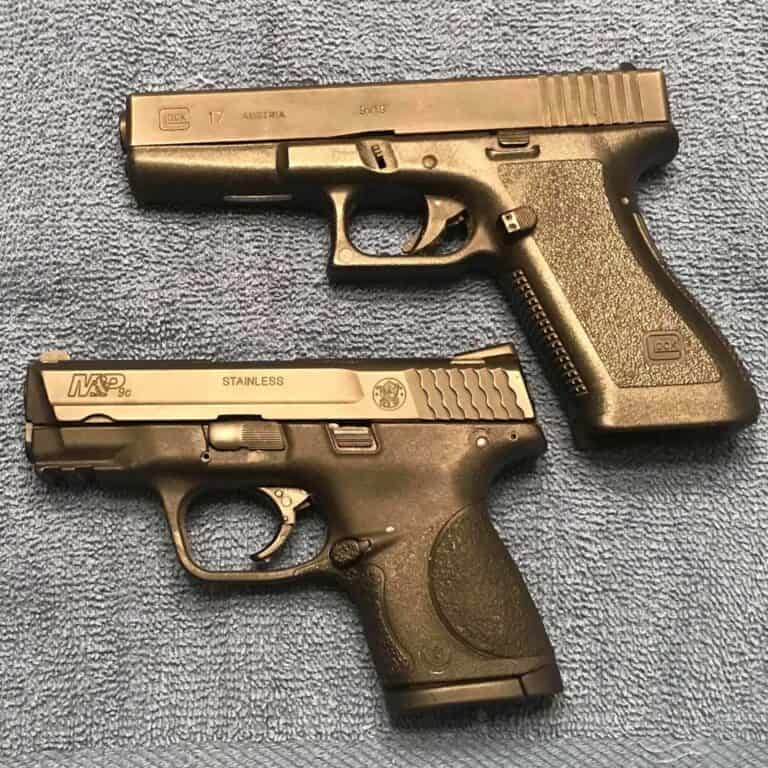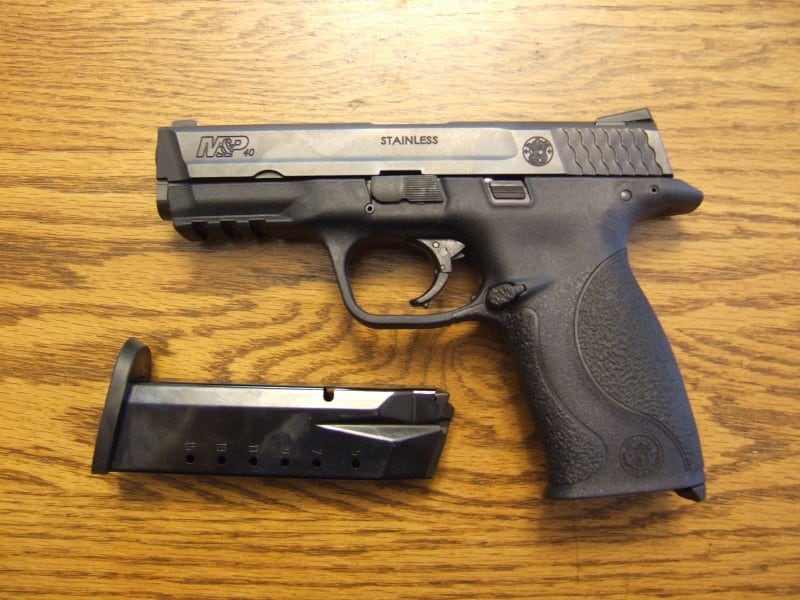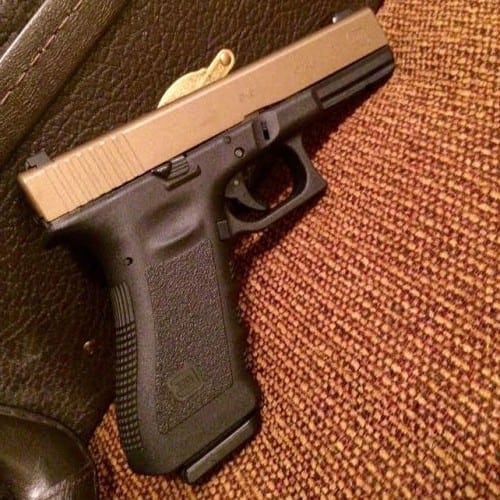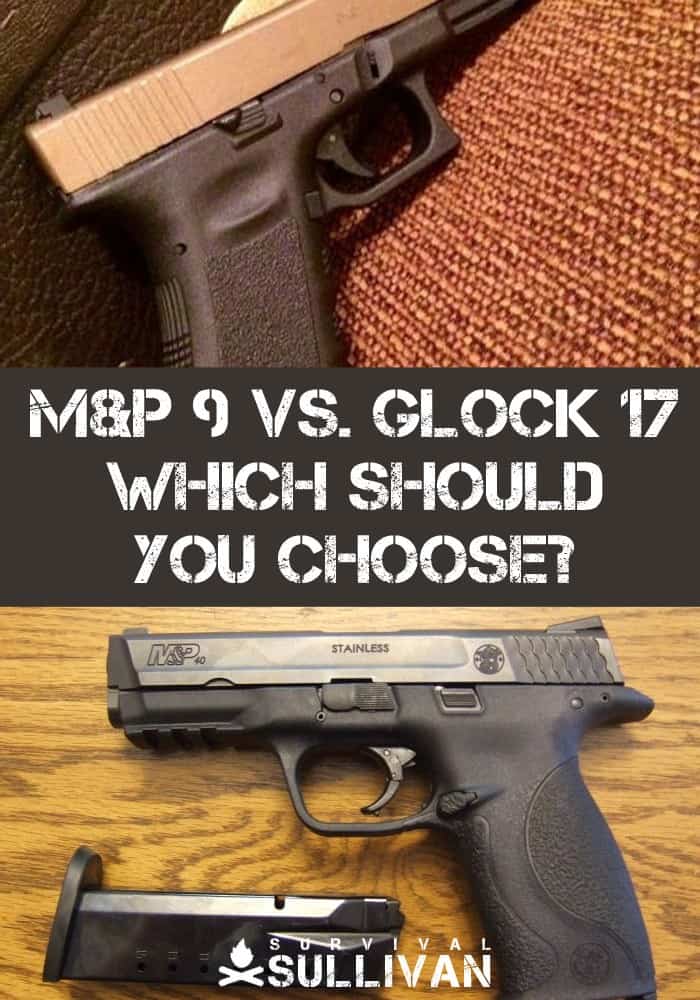In a crowded pistol market that is seeing significant innovation and nearly perpetual refinement, the weathervane of progress shows the wind blowing a-toward striker-fired actions as the best overall modern design paradigm.

This is not a bad thing: while not perfect, overall striker fired guns offer a combination of simplicity, ease of use, performance and low cost that is very hard to top with comparable hammer-fired guns.
The two emergent favorites among the striker pistol breeds are the longtime favorite and world-dominating champion, Glock, and the first, true domestic striker-fired gun to challenge it, the Smith & Wesson M&P.
Both guns are excellent in nearly every regard, and both can be taken to higher planes of performance with modification. But which ultimately is best?
This is no easy comparison, though endless hordes of fans will say otherwise. Both are good shooters, highly reliable, durable and accurate enough for most purposes. Both occupy a similar price point on the market. Both are widely chosen among police, agency and military forces. The race is close, a dead heat.
Can we say for sure which is superior? That’s what I have set out to do in today’s article.
Table of Contents
Foreword
In the interest of getting down to business so you can make a purchase decision, I am omitting my typical historical overview of the subject guns in question. I do believe that to fully understand where any artifact of man, guns included, fits in the world among others like it you must understand where it came from.
In the case of our subjects today, both emerged from what I call the Striker Pistol Wars of the early to late 2000’s to cement their respective statuses as iconic handguns to emulate, and both set precedents that competitors would quickly try to follow.
While very interesting, at least to me and other gun nerds, it does little to help us with the subject at hand. All you need to know is that these two pistols, the Glocks in particular, are the ones that all others in their category, even beyond their category, are compared against.
So forget the history lesson for now. If you care to read about it I and others have articles about just that published here on Survival Sullivan.
As for the rest of the article, I am comparing the guns in fullsize format and 9mm Luger. So, no, I will not be delving into a comprehensive comparison between the respective makers’ .45’s or anything else like that.
9mm is the standard today, and that’s what we’ll be comparing, though both of these pistols are also neck and neck when chambering .40 S&W.
Head to Head: Glock and M&P
From a practical standpoint, these two pistols are extremely similar. The manual of arms is essentially identical. You may well find after reading this article and handling both guns that you could simply base your selection on much smaller criteria like ergonomics, options, control layout, etc.
A little while back, the M&P enjoyed a major edge over the Glock in ergonomics. The M&P models all came with 3 interchangeable wrap-around grip-inserts to tailor the gun to the user’s hand, as well as ambidextrous slide releases and a reversible magazine release.
The Glock had no such features (and Generation 3 and earlier guns still do not) and any similar grip alteration was reliant on a slip-over grip sleeve, expensive shaping of the grip by a professional or other methods.
That changed with the introduction of the Gen 4 and Gen 5 Glocks, which now, finally, feature replaceable backstraps and reversible controls as well as a more aggressive grip texture.
Smith & Wesson would not sit on their haunches as Glock had done for so many years, and quickly retaliated by introducing the M&P M2.0 which featured a strengthened internal chassis, aggressive texturing and a better trigger to compete directly with Glock’s improvements over their legacy pistols.

Both the Glock and M&P enjoy frankly huge aftermarket and OEM support. Every major and most minor component in either gun has options available to customize, modify and in some cases actually improve performance.
Now, if one wanted to strictly make an old-school comparison, rather comparing legacy pistols against each other instead of the new iterations, Glock still enjoys a gargantuan lead in this respect when comparing Gen 3 and earlier guns.
With their release of the Gen 4 and Gen 5 models, however, which have finally introduced some significant internal changes and thus require generation-specific parts, this lead is not so crushing.

Glock pistols more or less come “as-is” and are functional copies of each other save caliber and optics mounting capability on the newest versions, whereas the M&P’s enjoy somewhat more variability in the form of optional manual safeties, Performance Center factory-tuned versions and so on.
Glock users can opt for the current top-of the-line Glock 17 MOS, but beyond that any serious performance upgrades are at the discretion of the owner.
In the accuracy department neither pistol is lacking, though Glock enjoys an accuracy edge compared to the M&P at least when stock, especially with their latest Marksman barrel on Gen 5 pistols which is a serious upgrade over their older ones, though it takes a pistol shooter of serious skill to really tell the difference.
At present time there has not been a large enough sample size of testing performed between the Gen 5 Glock 17 and M&P M2.0 to conclusively declare one more accurate than the other.
Each of these guns has forged excellent professional reputations based off of reliability first and foremost, with Glock’s reliability with this model especially being the stuff of legend.
This is further bolstered by the Glock’s near ubiquity with American law enforcement in addition to massive success with law enforcement and militaries across the globe.
Even with the M&P’s breakout success in the civilian and LE sectors, and a great track record of dependability, if I had to make the call on just one of these guns to work with no hiccups out of the wrapper, it would have to be the Glock.
Other small items of interest are things like the slide serrations, of which the M&P has fore and aft on the slide for easy manipulation no matter the technique being used. The Glocks, to this very day even with the latest models, only have rear serrations unless you have them custom-milled yourself.
The sights are also another point of contention; since the beginning, standard Glock sights are plastic, and horrible, being very easy to whack out of their dovetails entirely.
Sure, you can upgrade to factory steel sights, or night sights (which are steel) but this also erases the Glocks small price advantage over the M&P. All M&P sights, of any make, are steel as standard. For stock features and options, M&P wins.
Both guns are easy to maintain and service, but the Glock is so simple, so minimalist in nature it is a cinch to completely disassemble for whatever reason you might need to.
The M&P is no pain in the butt as far as pistols go, but just not as easy as the Glock. From a serviceability standpoint, Glock still reigns supreme.
Additions to the Lineup
There’s one thing you can say about firearms, and the industry in general: They never stand still.
Both Glock and Smith & Wesson continually add models to their respective lineups and refine legacy models to bring them more in line with modern standards.
For instance, Glock was among the first of the major manufacturers to introduce an adaptable line of optics-ready pistols in the MOS variations.
These guns benefit from all of the latter generation upgrades found on the standard line (improved mag release, slide stop, grip texture, etc.) but now come with slides pre-cut to accept a variety of the most popular MRDS optics on the market today, either through direct attachment or through the use of an adapter plate. They also still come with finger grooves…
Not to be outdone Smith & Wesson offers Optics Ready versions of their M&P 2.0 lineup that comes similarly milled from the factory ready to roll with an optic.
Both guns feature covers for these slots if optics are dismounted or not going to be used. This only makes eminent sense as handguns will continually move closer and closer to the MRDS as the standard and primary sighting system.
I remember when these tiny format optics were just starting to make inroads on “serious” handguns, and the naysayers and bubbas alike decried them as novelties or gamer BS. Like I always say, never trust a Fudd.
Moving swiftly along, both companies have also introduced several handguns to take advantage of one of the most popular segments of the market for civilians and police departments alike, that of the slick, slim, single stack.
Glock offers the model 43 and 48 whereas Smith & Wesson offers the M&P Shield.
For the ultimate in low-profile carry guns that give up very little in performance over there proper compact and full size brethren, either offering works wonderfully, and either can accept a variety of upgrades available to their larger parent models, including a trigger upgrade.
It is worth noting that the stick trigger on both companies’ pistols is quite serviceable, with the Glock guns in particular finally having a fairly distinct reset.
A particular note is Smith & Wesson’s Shield EZ model. This Shield utilizes a fairly novel type of squeeze-cocking mechanism protruding from the backstrap that radically reduces the force needed to run the slide.
They also utilize a magazine with built-in mechanisms that make it much easier to load for everyone and obviate the need of a magazine loading tool for those of reduced or limited capability.
Advertised as an ideal handgun for those who struggle with the dexterity or strength requirements attendant to utilizing a semi-auto pistol, these guns are still excellent shooters, and worthy inheritors of the M&P brand.
Determination
I can handily declare this shoot-out a tie in all respects when it comes to shooting and running these pistols. Only when you start to consider logistics, fleet usage and maintaining and repairing them over the long term do the Glocks advantages really start to shine.
This brings up a good point about aftermarket support and enhancement options also, which both guns enjoy in abundance. No matter which one you choose, you’ll enjoy a nearly endless supply of options.
Even so, the Glock’s greater maturity as a pistol, and its most prominent upgrades maturity in turn, does lend a bit more confidence than comparable arrangements with the M&P.
If I had to choose one, just one for the sake of argument I would choose the Glock.
While I prefer the M&P all the way around (ergos, trigger, handling, etc.) the logistical advantages conferred by the Glock along with its truly crazy track record of longevity, gets the nod from me for a gun to be used in a survival context, especially a long term one.
Since logistical concerns are of major import to preparation, and I care about such things, I’ll go with the Glock. BUT, in point of fact both pistols are nothing short of excellent, and you can hardly go wrong with either.
Conclusion
Both of these striker-fired pistols, the Glock 17 and the M&P 9 bring much to the table and offer any shooter many advantages.
Truly declaring one or the other superior comes down to hair-splitting and intangibles. Both are ubiquitous, both are durable, reliable and certainly perform well enough to bet your life on.
Hundreds of thousands of civilians and armed professionals do, with one or the other, every day. No matter which you choose you can be sure you can rely on it.


Charles Yor is an advocate of low-profile preparation, readiness as a virtue and avoiding trouble before it starts. He has enjoyed a long career in personal security implementation throughout the lower 48 of the United States.

Yeah, yeah… Glock vs the world. The issue here is carrying your hand gun with a live round in the chamber. Try this … Tie your left or right hand behind your back, now draw and fire, WITH ONE HAND. Obviously if you’re carrying, as you should with a striker fired weapon, with an empty chamber you are going to have a problem. Give me a wheel gun OR a Beretta M92/94, PX4. I can safely carry with loaded chamber and get into action very quickly with one hand with any of these weapons.
Bob,
I am highly curious as to what has led you to declare best practice with a striker-fired pistol is carrying it with an empty chamber, but not TDA semis or DA revolvers.
No modern handgun carried for defense should be carried with chamber empty.
-Charles
Agreed
Get a Sig P320 (M17) solves all issues.
Neither. Walther PPQ
PPQ is one of the nicest striker guns that almost no one wants, sadly. Walther has been gaining steam with the general population, though. I hope they gain the attention that that pistol warrants.
-Charles
Yeah, but… Look at that jerk FBI guy disco dancing with a loaded handgun. It falls out of his pocket or holster and goes off. First in most states carrying in a bar is illegal (Ex. Texas 50/50 law) but then he must have some sort of King’s – X that lets him ignore local laws. Striker fired semi’s carried cocked with a live round in the chamber are, in my opinion, dangerous. I discovered my son was carrying a small 9mm S&W in an IWB holster behind his belt buckle. For the sake of future generations, I implored him to change either the position of the holster or the type of hand gun. Being of the know-it-all generation, I imagine he blew me off.
Bob,
I agree about our dancing FBI agent. The entire thing was a carnival of idiocy, and you are quite right that any of us little people would have been squashed if we were in his place.
But in point of fact his issue pistol did not discharge when it hit the ground, as designed; it fired as he snatched at it in order to retrieve it and one of his fingers pressed the trigger.
Don’t worry about your son if he has trained and is using a good holster. AIWB confers many advantages even over strongside carry. Not my preference either, but it is a popular position once again after some hiatus. If he is not trained, or is carrying a gun there in anything but a high-quality leather or kydex rig, then you are right to flog him until he corrects the deficiency.
Take care.
-Charles